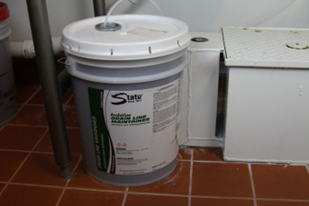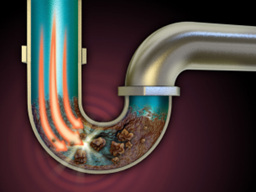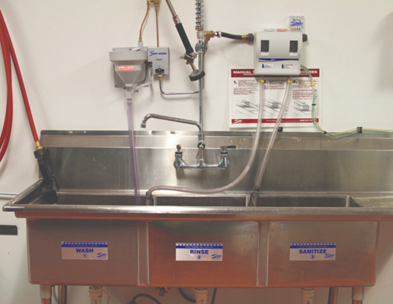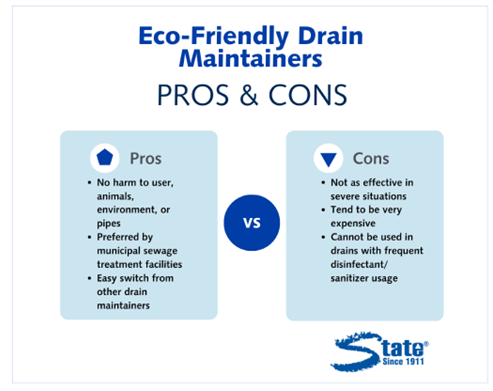Pros and Cons of Eco-Friendly Drain Cleaners
Pros and Cons of Eco-Friendly Drain Cleaners
Eco-Friendly Drain Cleaners Overview
Eco-friendly drain cleaners are the natural choice when you want to prevent clogs but also be mindful of your impact on the environment. However, choosing an environmentally friendly option can bring fears along with it. You may be thinking: What options are there? What’s the difference from an ordinary drain cleaner? How expensive will it be? Will it actually work? All these questions are justified and natural as you prepare to make your choice, but they leave one to wonder, “Where do I even start?”
At State Chemical, we have been selling drain maintainers for decades, including Ecolution Drain Line Maintainer, which is certified by UL Ecologo as environmentally friendly. There are a lot of products to scope out, and it’s not always easy to get straight answers, especially for niche topics. So, we’ve taken the time to weigh the pros and cons of environmentally friendly drain cleaners so you can make the best decision for your facility:
Pros and Cons of Eco-Friendly Drain Cleaners
- Pro: No Harm to the User or Environment
- Con: Not as Effective with Major Problem Areas
- Pro: Preferred by Many Municipal Sewage Treatment Facilities
- Con: Tend to be Very Expensive
- Pro: With Standard FOG Buildup, You Should Notice No Differences when Switching to Eco-Friendly
- Con: Cannot be Used in Drains with Disinfectants or Sanitizers
What Makes a Drain Cleaner Eco-Friendly?

Something interesting is that most drain cleaners can be classified as “eco-friendly” as long as they are made of natural ingredients. Because of this, certain harsh products like acids can fall under this umbrella. However, for the purpose of this article, we will be referring to bacterial products that cause no harm to the user or their environment when we say “eco-friendly drain cleaners.”
Bacteria-based drain cleaners work by releasing bacteria into your drain. After “waking up,” the bacteria eat through organic buildup in your drains. As long as they have a food source, the bacteria keep your drains clear, digesting the buildup into water and air. Bacterial strains used in a drain cleaner can vary, but they are always “good” bacteria, so you don’t have to worry about putting anything damaging down your drains.
So, what are the benefits and drawbacks of eco-friendly drain cleaners?
Pro: Eco-Friendly Drain Cleaners Pose Little to No Harm to the User or Environment
The most obvious benefit of eco-friendly drain cleaners is that you can use them without fear of causing bodily harm when used according to label directions. If accidentally spilled, eco-friendly drain cleaners should be safer for the user, animals, and the environment.
Additionally, pipes won’t be negatively affected by eco-friendly drain cleaners. Since the cleaners are made up of live bacteria, they eat through fats, oils, and greases (FOGs) to naturally clear drains. On the other hand, harsh acidic products disintegrate buildup, meaning they can cause damage to pipes over time.
Con: Environmentally Friendly Drain Cleaners Do Not Work as Well with Major Problem Areas

Because eco-friendly drain cleaners are safer to use, they can also be less effective in severe situations.
Imagine you’re working at a fast-food chain. Every time the fryer oil needs to be changed, the overwhelmed employees tend to dump it down the drain rather than in a grease disposal container. So, every few days, large amounts of oil flood the sink all at once, congealing on their way down. Just after the bacteria has made a sizeable dent in one batch, a new one pours down and builds up. If your drains are constantly experiencing a large influx of grease, eco-friendly drain cleaners are not the answer for you.
Eco-friendly drain cleaners also cannot be used as drain openers for this reason—they simply don’t work quickly enough. An eco-friendly drain cleaner might be able to work through badly congealed grease in 24-48 hours. But a stronger standard drain cleaner could work in the same drain in about 10 minutes.
Pro: Eco-Friendly Drain Cleaners are Preferred by Many Municipal Sewage Treatment Facilities
Every municipal sewage treatment facility has the ability to trace substances back to your organization by looking into manhole covers. From there, they can connect buildup in the main lines back to specific facilities’ sewer lines. When you put anything harmful down your drain, it’s recorded by your municipal sewage treatment facility. This means that you could be fined for offenses like dumping too much grease or using damaging chemicals.
With eco-friendly products, there’s no harm to the sewage treatment facility, and you’re preventing the harm that FOGs could cause. Many facilities also prefer the use of these products since they help the larger system by safely clearing out buildup on their way down.
Con: Eco-Friendly Drain Cleaners Tend to be Very Expensive
Another con with environmentally friendly drain cleaners is that they tend to be more costly. All products are different, and prices vary, but drain maintenance is an expensive investment. There are cheaper options available, such as some products that mix bacteria with other active ingredients, but again, it depends on your situation and needs.
Pro: If Your FOG Buildup is Standard, You Should Notice No Differences When Switching to Eco-Friendly
If you’re currently using a different drain cleaner, a benefit of switching to environmentally friendly is that you shouldn’t notice a change.
Your current drain cleaner controls the amount of FOG buildup you’re experiencing. As long as this buildup is not extensive, changing to eco-friendly should be a smooth process.
Meanwhile, if you’re not currently using a drain cleaner, you should notice improvements within several days depending on the amount of buildup you’re experiencing.
Con: Eco-Friendly Drain Cleaners Cannot be Used in Drains that Employ Disinfectants or Sanitizers

An important note is that bacteria-based drain cleaners cannot be used in environments that frequently employ disinfectants or sanitizers.
A good example of this is in a three-compartment sink. Bacteria-based drain cleaners will fare just fine in the washing and rinsing compartments, but that won’t be the case in the sanitizing compartment. The bacteria in these products are alive, and putting bacteria in chlorinated or disinfectant sanitizer will kill them, rendering your drain cleaner useless. Do not use bacteria in these kinds of drains.
If you’re looking for a drain cleaner for an environment that frequently uses disinfectants or sanitizers, we recommend a non-bacterial drain cleaner, such as an emulsifier.
So, What are My Next Steps?

You’ve decided to invest in preventative maintenance for your drains, and you want to be eco-friendly if possible. Now, you understand the pros and cons of these products and are prepared to take the next step and consider what you want to buy. If you’d like to continue exploring the drain maintenance process, now it’s time to learn about drain maintenance contracts.








